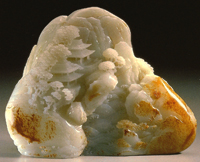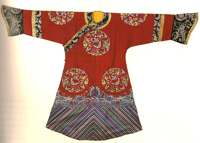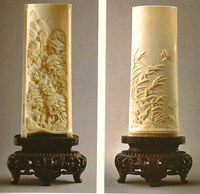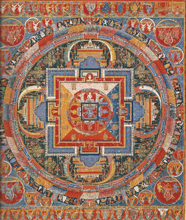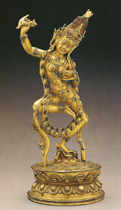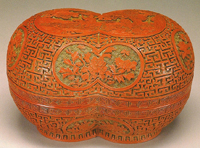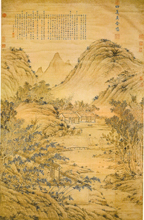Chinese Art Resources
Chinese art, as James Cahill points out, "...is the only tradition in the world art that can rival the European painting tradition in the sheer quantity and diversity of its output, the number of recorded artists of note, and the complexity of aesthetic issues attached to it, as well as the sophistication of the written literature that accompanies it through the centuries."
A full understanding of Chinese painting and calligraphy requires knowledge of Chinese art connoisseurship. Unlike American, European and French paintings, where professional artist are ranked higher than amateurs, Chinese culture has showed much more appreciation of traditional Chinese paintings and calligraphic works by amateur painters than those by professionals. Although it is not fair, it is true that professional artists in the ancient China were considered as craftsmen who made a living by creating art works. In the eye of a traditional Chinese art connoisseur, the elite group of amateur artists are indviduals who possessed the best education on Chinese classics and cultural traditions. They were seen as the highest Chinese cultural ideal-- scholars, civil servants of integrity and gentleman. If you wish to gain the skill to understand Chinese painting and calligraphy, in terms of subject matter, painter's mentality or creativity and brushstrokes, cultural symbolism, artistic achievement and visual excellence, you need to improve your understanding of Chinese visual culture by reading or studying serious scholarship on Chinese connoisseurship.
The introduction of the following Chinese art resources aims to direct your curiosity to good scholarship or publication. Only by reading serious writings, you will appreciate the real beauty of a Chinese painting and calligraphy scroll in its historical, cultural and artistic contexts.
Important Chinese Art References
Orientations is a magazine designed for connoisseurs, dealers and collectors of Asian art. It offers articles on art, exhibitions, and collections, and provides updates on major auctions in London, New York, Hong Kong, Beijing, Shanghai, and elsewhere.
The Palace Museum, Beijing is one of the most important collection in the world dedicated to Chinese art. Its collection of classical Chinese painting makes it one of the best Chinese art collections in the world .
The Shanghai Museum is one of the most important collections of Chinese art worldwide. It concentrates on literati paintings of the 13th and the 14th centuries.
The Tokyo National Museum has one of the best Chinese art collections, including paintings, calligraphy and decorative arts, of the Song (960-1279), Yuan (1279-1368), Ming (1368-1644) and Qing (1644-1911).
The British Museum (London) has the most conprehensive collection of Chinse art. Its Dunhuang collection is of particular research value, including stencils, illustrated manuscripts, silk and paper banner paintings from Dunhuang Library Cave 17 (discovered in 1900).
Freer and Sackler Galleries (Washington,D.C.) distinguishes itself from other museums dedicated to Asian art and Chinese art by housing many rare classical Chinese paintings and art objects. Their landscape paintings, figure paintings, Buddhist art, and flowers and bird paintings are among the best worldwide.
The National Palace Museum, Taipei houses a wide range of important classical Chinese paintings and imperial art objects. Its landscape paintings, figure paintings, Buddhist art, and decorative arts are critical to the study of Chinese material culture in the ancient times.
Collection of Classical Chinese Paintings presents famous traditional Chinese paintings currently housed in the Museum of Fine Arts (Boston).
How to Collect Chinese Art
Eight Principles
1. Let your cultural values, aesthetic interests, or investment goals be your guide. The new breed of Chinese art collectors comes from a wide range of backgrounds: retirees, mid-carrier executives, CEOs, homemakers, professionals, designers, artists, teachers, and so on. Don't be put off by stereotypes—they're not you!.
2. Educate yourself. Talk with a Chinese art expert, or visit museums, explore our on-line collection and others, or go to galleries. Take your time in defining your interests and the niche you are aiming for.
3. Take advantage of your position. Don't compete with the largest museums and wealthiest collectors who seek the few pieces of older Chinese art still available outside of China. Instead, buy wisely high-quality classical Chinese paintings, modern works in the style of old masters, and contemporary Chinese paintings that reflect the best of Chinese artistic traditions. Recent auction records show that the value of a Chinese paintings in this category is growing very fast in the Chinese art market.
4. Seek out quality pieces priced in the middle ranges. This assures you of the highest quality in the present and a greater value as the market grows in the future. It will also help you develop your own tastes and hone your Chinese art connoisseurship.
5. Never compete with rich Chinese art collectors, unless you have sufficient capital. American and Swiss collectors still dominate the bidding for the most expensive Chinese art in auction houses everywhere.
6. Look for well-educated artists with a colorful background who are respected for their artistic creativity, famous in their regions but have not yet been "discovered" by this international market. Sometimes, paintings by this group of artist are often better than the gift paintings and student paintings signed by the world-famous artists. Art works by this group are still affordable. If you have a vision and advanturous, it is never too late for you to dive into the Chinese art market.
7. See something you like, grab it before it is gone. Finding quality Chinese art objects of collectible quality has become increasely difficult. Therefore, you shouldn't hesitate if you see something unique or something that attracts your eye, or something that speaks to your heart. As long as the desired Chinese painting by a professional artist is reasonably priced, grab it before it is gone.
8. Focus more on quality less on originality. Chinese paintings are often identified as "original," "reproduction," "copy," "in the style of," "after," or "attributed to." Without many years of specialized study of Chinese art history, connoisseurship and years of collecting experience, it is very difficult to be certain about the originality of a Chinese antique painting. In light of many unsettled famous debates on the originality of Chinese antique paintings held in the museums and important collections, in my humble opinion, it will not be very helpful, if you are only interested in authenticity. In the real world, a proper authentication of an antique Chinese painting is very complicated. Instead, paying attention to the quality of an antique painting and the rank of a signed artist is practical. Consulting an art professinal specializing in Chinese art is necessary, if the subject painting bears the signature and name seals of a famous Chinese painter.
What to Collect
Fine porcelain objects made during the Republican period (1911-1949) are promising. The price of quality objects of the first half of the 20th century has gone up dramatically in the past 5 years. Paying attention to the masterpieces is always wise. Trying not to be tempted by jars with a Chinese character, " Double Happiness" motif is a must. Buyers should avoid purchasing porcelain items of less than perfect condition.
Chinese paintings by female artists have potentials. This is a very profitable market for new collectors or collectors with a small budget. Chinese paintings by seventeen Chinese woman artists of the Ming (1368-1644) and Qing (1644-1911) are in demand. The smoothly rising auction sales prices suggest that the value of fine classical Chinese Paintings by Female Chinese artist will continue to grow in the coming years.
Chinese fan paintings by professional artists are collectibles. Classical Chinese paintings of a folding fan format is particularly stronger than ever as compared with the round fan format. This format has been neglected by Chinese art collectors for a long time until very recently. It is wise to focus only on quality Chinese fan paintings created prior to 1949.
Have Questions about Asian Art? Need Professional Chinese Art Consulting Service? Need Asian Art Appraisal ? Want to Know more about the Chinese Art Market ? Want to Know Where and How to sell your Art?
Our Asian Art Appraisals are conducted by Dr. Wei Yang (Ph.D. in Chinese art, a certified art appraiser and an Accredited Senior Appraiser of Asian Art designated by American Society of Appraisers). We are committed to a thorough investigation of your art work, large or small. We serve you with respect, integrity and objectivity.
Need Asian Art Consultation or Appraisal? Please Contact Us or call us at (609) 688-6891
We Consult & Appraise Asian Art
